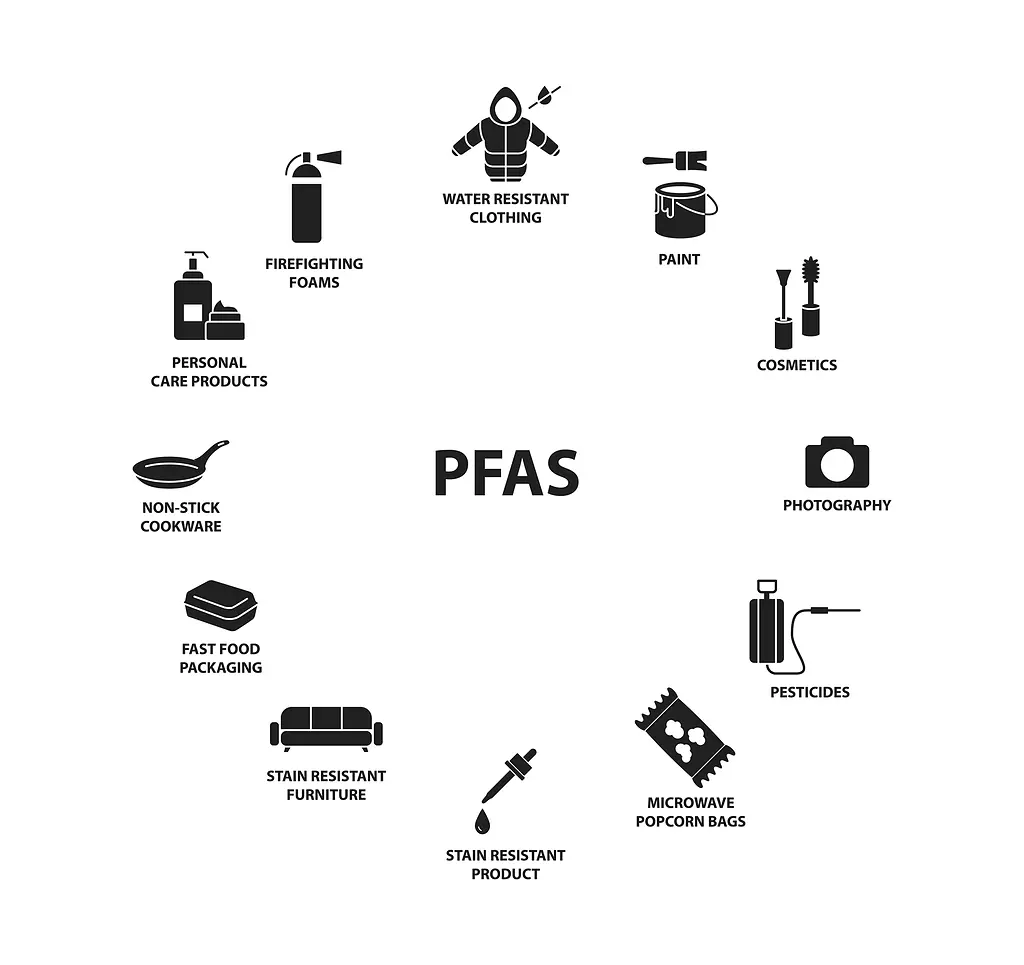Have you microwaved a bag of popcorn recently? Did you put stain-repellent on your couch or use carpet cleaner for that spill? When did you last floss your teeth? Do you need a rain jacket or rain boots today? Are you cooking breakfast on your no-mess, non-stick pan? If you said yes to any of these things, then you probably just used per- and polyfluoroalkyl substances.

PFAS are used in a variety of consumer products, even though you can’t usually find them on a label. If it is non-stick, water-resistant, or stain-repellent, there is a good chance that the product contains some of the more than 5,000 PFAS compounds identified to-date.
Historic Use of Per- and Polyfluoroalkyl Substances
“Forever chemicals” are human-made compounds that do not easily break down in the environment or human body. They are also called per- and polyfluoroalkyl substances (PFAS). Because they repel grease, oil, and water, they are used in products like nonstick cookware and food packaging, waterproof and stain-resistant clothing and textiles, and firefighting foam and protective clothing.
While they have been used in consumer products since the 1940s, there has been little regulation to-date on their production or allowable use. Where PFAS are produced, they can be discharged into air or local waterways, such as the Cape Fear River Basin in North Carolina and the St. Paul area in Minnesota. Since PFAS do not degrade easily, PFAS may be in municipal biosolids applied to farms, landfills, septic tanks, surface water, groundwater, and other areas were PFAS were used or disposed of including manufacturing facilities, military bases, airports, and fire-fighting locations.
You cannot taste, smell, or see PFAS, but once they get into the environment, they can travel into the water you drink, the air you breathe, and the food you eat. Exposure to PFAS from consumer use or environmental contamination can increase the chance of certain cancers, along with problems like thyroid disease, high cholesterol, high blood pressure, and a reduced immune response to vaccines.
Because of expanding concerns, U.S. Environmental Protection Agency (EPA) Administrator Michael Regan established the EPA Council on PFAS in April 2021 to address PFAS contamination and support communities across the U.S.
Strategic Roadmap to Confront Per- and Polyfluoroalkyl Substances
This week, Regan announced the Biden administration's comprehensive Strategic Roadmap to confront PFAS contamination nationwide, based on the EPA Council’s recommendations. The strategy is focused on three pillars:
- Increasing investments in research.
- Leveraging authorities to act now to restrict PFAS chemicals from being released into the environment.
- Accelerating the cleanup of PFAS contamination.
In the press conference, EPA Administrator Michael S. Regan stated “For far too long, families across America – especially those in underserved communities – have suffered from PFAS in their water, their air, or in the land their children play on. This comprehensive, national PFAS strategy will deliver protections to people who are hurting, by advancing bold and concrete actions that address the full lifecycle of these chemicals. Let there be no doubt that EPA is listening, we have your back, and we are laser focused on protecting people from pollution and holding polluters accountable.”
EPA’s roadmap includes regulatory development, research, and funding to address PFAS, as follows:
- Regulatory development includes an “aggressive timeline” to set enforceable maximum contaminant levels under the Safe Drinking Water Act for select PFAS compounds, a hazardous substance designation that will make polluters accountable under the Superfund law, and effluent guideline limitations under the Clean Water Act. EPA already started the rule development process for designating PFOA and PFOS as hazardous substances, is in progress to set primary drinking water standards for PFOA and PFOS, and announced actions to stop companies from dumping PFAS into waterways.
- Research will include re-evaluating PFAS reviews under the Toxic Substances Control Act, increasing monitoring and data collection on PFAS compounds, performing toxicity assessments for Gen X, one PFAS compound, and further researching how PFAS are emitted into air. EPA already formed a workgroup to discuss regulating PFAS as categories, proposed a rule to expand data collection, is planning to expand nationwide drinking water monitoring, announced better PFAS usage review and updated toxicity assessments, and released Toxic Release Inventory data.
- Funding could potentially include more than $10 billion to address PFAS contamination through the Biden Administration’s Build Back Better agenda and the national infrastructure bill to expand research and address PFAS contamination nationally.
EPA is holding two national webinars for interested stakeholders on October 26 and November 2. Additional information on EPA’s Strategic Roadmap can be found on their website at www.epa.gov/pfas.
At RTI, our teams are supporting the call to “act now” by providing technical research support to identify and mitigate environmental health concerns from forever chemicals. Learn more about our PFAS capabilities and research. You can also check out RTI and Indiana University’s community-engaged research on PFAS in well water, by visiting our Clean Water for US Kids™ website.

